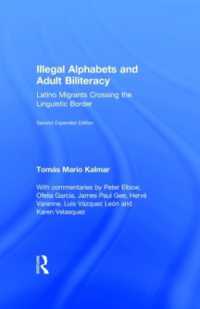- ホーム
- > 洋書
- > 英文書
- > Religion / Ethics
Full Description
Since the earliest encounters between tantric traditions and Western scholars of religion, tantra has posed a challenge. The representation of tantra, whether in Bengal, Tamil Nadu, Tibet, or Japan, has tended to emphasize the antinomian, decadent aspects, which, as attention-grabbing as they were for audiences in the West, created a one-dimensional understanding, and hampered the academic study of the field for more than a century. Additionally, the Western perspective on religion has been dominated by doctrinal studies. As a result, sectarian boundaries between different tantric traditions are frequently replicated in the scholarship, and research tends to be sequestered according to different schools of South Asian, Central Asian, Southeast Asian, and East Asian tantric traditions.
The Oxford Handbook of Tantric Studies is intended to overcome these obstacles, facilitating collaboration between scholars working on different forms of tantra. The Introduction provides an overview of major issues confronting the field today, including debates regarding the definition and category of "tantra" historical origins, recent developments in gender studies and tantra, ethnography and "lived tantra" and cognitive approaches to tantra. Using a topical framework, the opening section explores the concept of action, one of the most prominent features of tantra, which includes performing rituals, practicing meditation, chanting, embarking on a pilgrimage, or re-enacting moments from a sacred text. From there, the sections cover broad topics such as transformation, gender and embodiment, "extraordinary" beings (such as deities and saints), art and visual expressions, language and literature, social organizations, and the history and historiography of tantra. With co-editors in chief who specialize in the Hindu and Buddhist perspectives, a global pool of contributors, and over 40 chapters, the Handbook aims to provide the definitive reference work in this dynamic field.
Contents
1. Tantric Studies: Scholarly Issues, Methodologies, and Collaborations
Richard K. Payne and Glen A. Hayes
Part I. Action
2. Initiation (Abhi.seka) in Indian Buddhism Ronald M. Davidson
3. The Inner and Outer Worship: The Rhythms of Domestic and Temple Practice in Nep=al=i Tantra
Jeffrey S. Lidke and L. S. Akshunna
4. On the Union of Emptiness and Bliss: Buddhist Thought and Tantric Practice
Paul Donnelly
5. Gory=u Shint=o Goma: Tantric Foundations
Richard K. Payne
6. Homa in Jain Traditions.
Ellen Gough
7. The Neuroscience of Tantric Practice
Geoffrey Samuel and Maria Kozhevnikov
Part II. Transformations: Soteriology, Astrology, Alchemy, and Healing
8. Cosmic Process, Philosophy, and Soteriology in the Works of Abhinavagupta
Sthaneshwar Timalsina
9. Esoteric Physiology and Subtle Body Systems
Glen A. Hayes
10. Transforming the Body by Mastering the Elements, Some Tantric Sources
Lubomír Ondra^D%cka
11. Cosmology and Embryology in Medieval Japan
Anna Andreeva
12. Astrology and Astral Magic in Tantric Japan
Jeffrey Kotyk
13. Tantric Dimensions of Alchemy
Patricia Sauthoff
Part III. Gender, Cosmogony, Embodiment and Power
14. 'Sr=ividy=a and Goddess Traditions: A Critical Historiographic Essay
Anna A. Golovkova
15. The D=akin=i in Indo-Tibetan Buddhism
Judith Simmer-Brown
16. Three Shades of Tantric Yoga: Chapter 20 of the Netra Tantra
David Gordon White
17. Generative Buddhahood: Enlightened Plants and Trees in Japanese Tendai Esoteric Buddhism
Matthew McMullen
18. Embodiment and Subjugation: Exoteric-Esoteric Buddhist Practice in Medieval Japan
Eric Haruki Swanson
Part IV. Extraordinary Beings: Deities and Founders
19.








